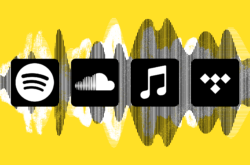Illustration: Filip Fröhlich
As a listener, you can explore and compare many options and choose the streaming service that works best for you.
On the other hand, as an artist who needs to build a presence on every distribution platform, which basket(s) should you put more eggs in? In this article, we explore the various factors you may want to consider when it comes to determining which streaming service is your best fit as an artist.
What are your options?
Before you can begin to identify which streaming service is most compatible with your music, it’s important to understand the market share of music listeners—so let’s break it down. According to Statista, in the first quarter of 2021, 32% of music streaming subscribers worldwide had a subscription with Spotify, 16% with Apple Music, 13% with Amazon Music, 13% with Tencent Music (China), 8% with Google (YouTube Music), and the remaining 18% with Netease (China), Deezer, Yandex Music, Pandora, and others.
It’s no big surprise that Spotify is currently dominating the music market, followed by Apple and Amazon Music. Even so, if you’re someone looking for global exposure, you’ll want to consider distributing your music to the likes of Tencent Music, Netease, and Yandex Music. However, for the scope of this piece, we’ll be focusing on the big two: Spotify and Apple Music.
Spotify vs. Apple Music
First, let’s address the elephant in the room. Yes, Spotify does currently have double the listeners that Apple Music has, and that’s definitely a strong consideration—but more doesn’t always mean merrier. It’s all about which platform can offer you more potential for growing your audience in terms of their demographic, discovery opportunities, and audio quality.
Listener demographics
For analyzing the listeners of each platform, we’ll be specifically looking at the age and gender of the user base. This will help you consider which age group and gender segment match your target audience.
In 2021, out of the active Spotify users in the U.S., 29% fell between 25 – 34 in age, 26% between 18 – 24, 16% between 35 – 44, and 11% between 45 – 54; 19% were 55 and over. Comparatively, according to Statista’s 2018 data, 23% of Apple Music users in the United States fell between the ages of 25 – 34 and 55+, 22% between 35 – 44, 17% between 18 – 24, and 15% between 45 – 54.
The interesting discovery about this data is that over half of Spotify’s user base is under the age of 35, and over half of Apple Music’s user base is over the age of 35. This means that if you’re looking to grow your reach to younger audiences, Spotify should perhaps be your focus. However, if your target audience is over the age of 35, Apple Music might be the platform you should be looking at more.
In terms of gender, 56% of Spotify users were male and 44% were female. On the other hand, 56% of Apple Music users were female and 44% were male. Gender isn’t a huge consideration for everyone’s music (and rightfully so), but this data can allow you to think about who your music resonates with and which platform can help you find more of those people.
Discovery opportunities
Whether you’re a new artist at the beginning stages of your career or a veteran trying to reach newer audiences, discovery is a crucial part of your musical journey. Although understanding your target audience is the first step, learning how to optimize discovery tools to grow your listeners is one of the most important steps you can take as an artist.
Spotify
As the key streaming platform to drive playlist culture, Spotify handcrafts thousands of editorial playlists that are followed by millions of listeners and offers personalized playlists—like Discover Weekly, Daily Mix, and Release Radar—that are different for each listener. Whether or not playlists are your cup of tea is for you to discover by pitching your upcoming release to be considered for editorial playlists and featured on your followers’ personalized playlists.
Furthermore, Spotify provides artists an option to run in-app ‘Marquee’ campaigns, a full-screen sponsored recommendation of your new release to Spotify Free and Premium listeners who’ve shown interest in your music and have the potential to listen to more of it. Budgets for Marquee campaigns start at $250 on a cost-per-click basis and allow you to target listeners based on their listening history, right when they’re deciding what to listen to.
Lastly, you can showcase your artistry on Spotify by customizing your profile—changing your bio or photos and recommending your favorites on your record via the Artist Pick, a fundraising link, or feature playlists. Canvas is another feature that helps you engage with your audience with short looping visuals for your tracks.
Apple Music
Similar to Spotify, promoting your music on Apple Music does revolve around playlisting. However, what’s different about Apple Music is that their curators don’t hold a monopoly over the most-followed playlists on the platform. Many of the most-followed playlists on Apple Music are curated and / or sponsored by different brands and labels, like Filtr, The Voice, Disney, and Mom + Pop Music. This means that you have a unique opportunity on this platform to pitch your music to playlists from outside Apple Music editorial team (like our very own NOTED. by Splice).
On the other hand, unlike Spotify, which features third-party playlists from record labels and publications, Apple’s owned playlists are all either curated by Apple’s editorial team or a select group of partners. Hence, if you’re one of the lucky few who can personally connect with the curators, you can pitch directly to them. Moreover, you have the opportunity to drop exclusives on Apple Music, which will increase your chances of getting featured on Apple’s coveted playlists. That said, you should only go for the Apple-exclusive campaign if the majority of your fanbase uses Apple music.
The discovery features mentioned above will help you consider which platform to invest more of your time, energy, and money in. If playlisting is your go-to method for getting discovered, Apple Music has more opportunities to get placed on playlists more popular than their own curated ones. On the flip side, Spotify also has unique discovery options beyond playlist culture.
Pay per stream
We understand that like countless other artists, you may make music for a living. One of the key aspects of that is the money you make from streaming. While pay per stream can be complex and evolving depending on the platform, SoundCharts has a detailed report that may be a useful resource to learn more about this topic for Spotify, Apple Music, and more. At the end of the day, it’s important to take into account which streaming platform is going to foster the growth of your community and help you amass more streams.
Audio / streaming quality
When we release our music, we want our listeners to experience the highest-quality sound possible when they’re streaming. Let’s dive into which streaming service helps achieve that.
In Feburary of 2021, Spotify announced Spotify HiFi, which will reportedly deliver music in CD-quality, lossless audio format with more depth and clarity. In the meantime, Spotify currently offers a maximum streaming quality of 320 Kbps for Premium listeners and 160 Kbps for Free listeners, supporting AAC and Ogg Vorbis formats.
According to SOUNDGUYS, Apple Music will provide you with an audiophile-grade streaming experience, where you can stream 16 bit / 44.1kHz, 24 bit / 48kHz, and 24 bit / 192kHz along with spatial audio through Dolby Atmos content. Apple Music also streams content at 256 Kbps, utilizing the AAC audio format.
Which streaming service factors are more important for you in this stage of your music career?
In conclusion, with the facts laid out above, you have to ask yourself which factors matter the most to you in the current stage of your career. For instance, if you’re a new artist still discovering your audience, you might want to focus less on listener demographics, pay, and audio quality, and spend more time on getting discovered through playlisting and in-platform advertising opportunities. However, if you’ve already built a listener base, you’ll want to think more about platform demographics, pay, and audio quality.
In discovering who you are as an artist, we hope this data will help you understand your path and reach as many listeners that will resonate with your music as possible.
Explore royalty-free sounds from leading artists, producers, and sound designers:
January 7, 2022



